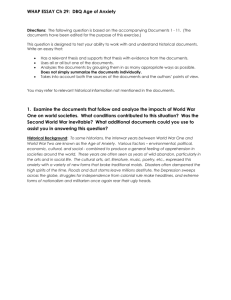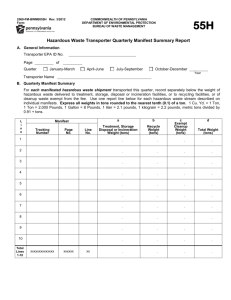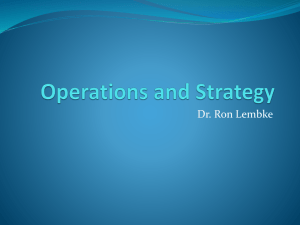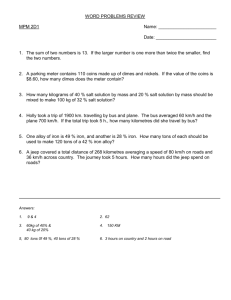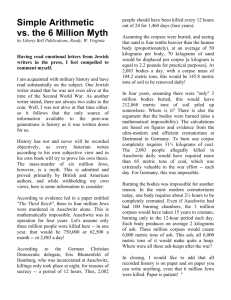Project-Based GHG Credits: A Market Vision and Potential Roles
advertisement
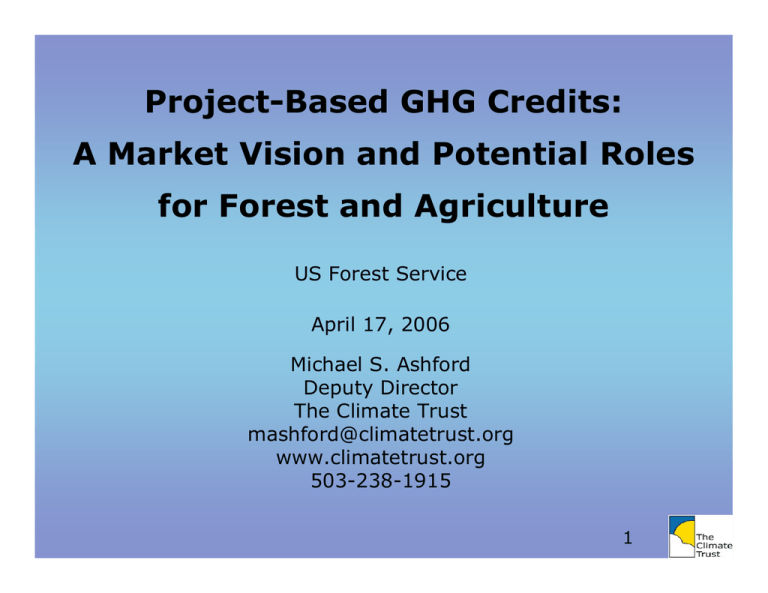
Project-Based GHG Credits: A Market Vision and Potential Roles for Forest and Agriculture US Forest Service April 17, 2006 Michael S. Ashford Deputy Director The Climate Trust mashford@climatetrust.org www.climatetrust.org 503-238-1915 1 Topics Covered • • • • • • Take away: Offsets must be of high-quality Visualizing climate change impacts What is a high-quality GHG offset Why are offsets valuable? The Climate Trust Portfolio Deschutes River Riparian Zone Reforestation • Closing Remarks 2 3 © The Climate Trust; 2003 4 5 One Immediate Challenge 31 Proposed Coal Plants in the Interior West* Many more nationally (70 to 120 by 2012) Great F al ls ) C ircle ) T hompson R iv er ) Roundup Hardin ) MONTA NA C row Otter C reek ) ) ) Wy gen T wo Elk and Midd le Bear ) ) Glenns F erry ) ) ) ) ) Bonanza Val my Sempra 2 NEVAD A ) ) H unter Sigurd ) Li mon ) Pueblo ) Wh i te P ine C ounty H arry Allen Juleburg ) IPP New mon t 2 ) ) WYOMIN G N ewmon t Grani te F ox Medic ine Bow IDAHO ) UTAH COLOR ADO ) Steag ) ) H opi ) Springerv ille ARI ZON A ) ) Lamar ) BH P ) Mus tang NE W MEXICO * Calpine Testimony Before the Oregon Department of Energy, Portland, Oregon, October 26, 2004 6 Take Away: Need High Offset Standards Projects Must Create “Additional” CO2 Reductions • Weak offsets now could allow compliance with nominal regulations while atmospheric GHGs rise • Must be mitigation measures that would not occur without offset project funding – Excludes common practice, regulated activities – Performance standards can be used as a surrogate 7 On-Going Third-Party Verification 8 Offsets Reduce GHG Levels Offset Defined: Synthesized from Dictionaries A project that… 1. Cancels out emissions 2. That are recorded in a GHG ledger (or the atmosphere) 3. With an end effect as if the cancelled emissions had not occurred 9 Additionality of a Project Activity CDM/JI Under Kyoto Protocol Emission reduction shall be additional to any that would occur in the absence of the certified project activity. Kyoto Protocol, Article 12 A CDM project activity is additional if anthropogenic emissions of greenhouse gases by sources are reduced below those that would have occurred in the absence of the registered CDM project activity. CDM modalities & procedures, paragraph 43 © Copyright 2004 IETA/PCF 10 11 CO2 emissions What is an Offset? The baseline case / validation Baseline emissions Offsets Project emissions The project case / monitoring & verification Project begins years Project ends 12 * Why Is Trading Valuable? To save scarce resources for other societal needs • “Cap and Trade” Logic: The gains of trade Marginal cost of GHG reduction for given “market” $15 $5 Will buy at $10 and save $25 Will sell at $10 and break even Trading Price = $10 • Both emit 100 tons and have 95 allowances = both short 5 • Without trading: Purple spends $75, Orange $25 – Total expenditures of $100 • Assume allowance market price is $10 per ton • With trading: Orange generates 10 tons at cost $50, sells 5 at $10 per ton to Purple (-$50) and breaks even – Total expenditures of $50 Society saves $50 *Prices are for illustrative purposes only 13 Why Are Offsets Valuable? * To save scarce resources and achieve more reductions • Introducing Offsets: A new market dynamic Marginal cost of GHG reduction for given “market” $15 $3 $5 Will buy at $3 and save $35 Will buy at $3 and lose $15 Will sell at $3 and earn $30 Offset Price = $5 • Both emit 100 tons and have 95 allowances = both short 5 • Assume allowance market price is $10 per ton • With trading: Orange generates 10 tons at cost $50, sells 5 at $10 per ton to Purple (-$50) and breaks even – TRADING ONLY: Total expenditures of $50 • With Offsets: Orange buys 5 at $3 and Purple buys 5 at $3 – TRADING WITH OFFSETS: Total expenditures of $30 Society saves $20 more than under trading without offsets *Prices are for illustrative purposes only 14 Why Are Offsets Valuable? • Achieve more reductions in non-capped sectors under cap and trade • Support investment in low-carbon technologies – long-term goals • Realize co-benefits – Other environmental – Socio-economic • Jobs, investment, environmental justice • Achieve regional / local policy goals 15 Benefits of The Climate Trust’s Offset Portfolio Most Projects and Benefits are in Oregon • 1.7 million short tons of CO2 offsets • Numerous other benefits – Reduce air pollution – Improve habitat, watersheds, and water quality; reduce soil erosion; preserve biodiversity; protect endangered species – Create jobs; create demand for clean energy products – Save money on energy; enhance energy security by reducing oil imports – Less traffic congestion • Benefit to cost ratio: 9 to 1 • Will invest another $5 million in 2006 16 Dry-Ice for Fire Suppression 17 Truck Stop Electrification • I-5 Corridor in OR and WA • “shutting-down-and-plugging-in” shifts from diesel idling to lower carbon grid electricity • Emissions co-benefits: – 1,400 tons of oxides of nitrogen (NOx), 40 tons of particulate matter (PM) • • • • OEM increasingly “electric ready” = pent up demand Saving estimated 10 million gallons of diesel fuel 16 year contract 90,000 metric tons CO2 18 Portland Building Energy Efficiency • MAP project increases number of multifamily housing units with a onestop shop for project coordination, technical and financial advice, and incentives. • The CGBP encourages highly efficient LEED Green Building Standards. • Deemed savings makes M&V viable technically and economically • Partner: Portland Office of Sustainable Development. • Tons: 247,888 Term: 5 years 19 Cement Substitution • Increase use of blended cement in eastern and western states • Project goal: stimulate a developing environmental market • Project and retail components • Strict M&V traces blend to manufacturer, mixer or project owner • Partner: East Coast Sustainable Design and Engineering Firm • Tons: up to 350,000 Term: 3 years, with option to extend 20 Innovative Financing of Wind Power • Non-profit supporting Green Tags market retires tags • Climate Trust retires carbon offsets • Set groundwork for developing policies on green energy and emissions reductions markets • Early transaction involving energy and emission credits markets • Finished 7 years early • Tons: Over 23,000 Term: 10 years, completed early 21 Internet-Based Carpool Matching • Internet-based matching service greatly enhances speed, convenience, and safety of finding carpools and vanpools • Extensive marketing of service is underway • Transportation demand management expert has designed and will implement monitoring and verification of CO2 benefits • Partners range from Salem OR to Vancouver WA – Cities, transit agencies, state agencies, transportation management associations, large private employers • Project statistics: – Tons: 70,000 Term: 10 years 22 Portland Traffic Signal Timing • Portland Department of Transportation with potential expansion to other counties and state • Millions of dollars in enduser savings • Strong data model for deemed reductions on conservative projections • Project statistics: – Tons: ca. 75,000 – Term: 5-10 years 23 Lumber Mill Cogeneration • Biomass cogen and process upgrade • Challenging to work with stressed economic sector • Very solid M&V (low cost and accurate) • Project statistics: – Tons: ca. 23,000 – Term: 15 years 24 Industrial Energy Efficiency • Blue Heron pulp and paper industrial facility, Oregon City, OR • Reduce energy use by 25% • Increased capacity to use recycled paper as a raw material • Project Statistics: – Tons: 640,000 tons CO2 – Term: 10 years 25 Ecuador Rainforest Reforestation • Leading Latin American conservation organization (Jatun Sacha Foundation) with proven track record will reforest 600 acres with rare, endangered, endemic trees • Site is the prime preservation target within the Ecuadorian biodiversity “hot spot” selected by Conservation International as one of its top five conservation targets world wide • Provides 99-year conservation easement with clear intent for permanent preservation • Partners: Conservation International & Jatun Sacha Foundation • Project statistics: – Tons: 65,500 Term: 99 years 26 Preservation of Unique NW Forest • Trust funding assists Lummi Tribe in acquiring 1600 acres of land in northern WA and removing it from forest harvest cycle • Project provides 100-year conservation easement, which protects ecologically unique forest, salmon habitat, and ceremonial lands • Leading scientist to prepare monitoring and verification plan • Partners: Lummi Indian Tribe • Project statistics: Tons: 350,000 Term: 100 years 27 Deschutes Riparian Reforestation • Central Oregon reforestation with local NGO • Native species / strong cobenefits • Rehabilitation of troutbearing streams • Groundbreaking “escrow” method • Project statistics: – Tons: 233,333 – Term: 52 years 28 Deschutes Riparian Reforestation • Additionality: – Insufficient incentives to landowners under existing federal programs – More sophisticated M&V over longer time (escrow) – Indigenous species – More burdensome legal structures 29 Deschutes Riparian Reforestation • M&V plan describes how the verifying agency (“verifier”) will: – Assess stand establishment, – Measure baseline carbon stock, – Re-measure carbon stock to find change over time, and – Conduct ongoing site monitoring. • For each of these assessment activities, methods are described for designing assessments, collecting data, analyzing data, and reporting results. 30 Deschutes Riparian Reforestation • The plan is composed of several sections: – Overall project planning issues – Stocking surveys and free-to-grow certification – Baseline carbon stock measurement – Carbon stock re-measurement – Periodic monitoring – Schedules of activities – Budget 31 Deschutes Riparian Reforestation • The baseline carbon stock and subsequent measurements of carbon stocks at later times all use the same protocol and measure the same items. Under the DRR project with the Climate Trust sequestration is defined as any increase in biomass carbon stock over time. 32 Deschutes Riparian Reforestation • “An adjusted amount will be reported that excludes amounts stored on lands under federal conservation incentive programs, during the time that those federal contracts are in force. These amounts are called ‘adjusted verified projected carbon dioxide offsets’”. • Projections will be made by growth modeling or use of tree or stand growth curves, using information about areas and species planted and site productivity. Reports will list inputs used in growth modeling so that, at some later time, if a different model is used to project sequestration then later projections can be compared to earlier projections.” 33 US Regulatory Drivers Today • • • • • • • • The Oregon Standard The Washington Standard The Massachusetts Standard The New Hampshire Standard RGGI California’s Initiatives West Coast Governors’ Initiative Anticipated Federal Regulations 34 Domestic Developments • Senator Feinstein: Strong Economy and Climate Protection Act of 2006 – No-till or conservation tillage – Storing additional carbon in the soil by tilling the soil less or not at all while farming. – Planting trees or grasses on unused land – Storing additional carbon in the soil by planting trees or grasses on low-value rangeland or shelterbelts between croplands. – Planting biofuel crops – Growing crops or using other materials for ethanol or other biofuels, which are alternatives to gasoline. – Biomass – Producing electricity with less or no fossil fuels, including using tree material from hazardous fuels reduction and switchgrasses or manure to generate power. – Grazing – Intensively-managed grazing systems that store more carbon in soils. 35 International Developments • Climate, Community and Biodiversity Alliance (CCBA) – Develop methodologies for land-use-based carbon offsets. – Members include • • • • • • • Conservation International BP Intel Hamurg Institute for International Economics The Nature Conservancy. ENCOFOR –EU-funded BioCarbon Fund of the World Bankt. 36 Closing Remarks: What are people calling an “offset” right now? • Voluntary-market offsets or allowances: – Varying environmental quality and regulatory efficacy. • Green power programs / RECs / Tags: – May be subsumed into GHG reduction goals • Energy conservation programs: – May or may not be part of GHG mitigation credit for regulated utilities 37 Quality Projects: Selection Criteria Fundamental Issues • Additionality – offset funding is necessary for the project to move forward • Permanence, timing leakage – Technology and implementation have high likelihood of achieving goals • Measurability and Verification – Quantification using best available analytical methods appropriate for the project (M&V) • Guarantees – If reductions not achieved, capital returned 38 Is a REC a GHG Offset? Assume: 1 mwh = 1 metric tons CO2e BEFORE REC Sale as an Offset = 1,000 metric tons CO2e 1,000 metric tons CO2e 1,000 mwh 0 metric tons CO2e 1,000 mwh (A1: maybe) (A2: probably not here) AFTER REC Sale as an Offset = 1,000 metric tons CO2e 1,000 metric tons CO2e 1,000 mwh 0 metric tons CO2e 1,000 mwh 1,000 metric tons CO2e from RECS coal wind coal wind 39 Need High Offset Standards Projects Must Create “Additional” CO2 Reductions • Weak offsets now could allow compliance with nominal regulations while atmospheric GHG rises – Mitigation measures that would not occur without offset project funding • Excludes common practice, regulated activities • Performance standards can be used as a surrogate – Project must be new to reduce atmospheric GHG 40 Humanitarian Issue? • More than the environmental / economic toll, this may soon become a moral, humanitarian issue – Malaria and dengue fever on the rise – WHO. “Climate Change and Vector-Borne Diseases: A Regional Analysis.” Bulletin of the WHO, 2000. http://whqlibdoc.who.int/bulletin/2000/Number%209/78 (9)1136-1147.pdf. – Poor countries coastal areas will be impacted, least able to respond • Georgia Institute of Technology and Massachusetts Institute of Technology peer-reviewed studies on GHG contribution to greater storm intensity, if not frequency 41 Two Weeks After Katrina Hit 42 We Have to be Optimistic (We can’t afford to be pessimistic) • All options need to be on the table – the problem is too great • We can start acting now – Do your part at home and in your community – Discuss climate change • High-quality offsets can achieve more at lower cost 43 Thank You Michael S. Ashford Deputy Director The Climate Trust mashford@climatetrust.org www.climatetrust.org 503-238-1915 44

